Wednesday 29th April
25 years ago both of us worked for ICL (the UK computer company later owned by Fujitsu), and used to come up to Manchester by train or plane from Devon – we both worked from home. So we were familiar with Piccadilly, a couple of hotels, and the taxi ride to the office at West Gorton. This was a tower block in a dismal part of the city, with condemned blocks of flats on the other side of the road amid vandalised shops and desolation, but there were views of the Pennines once you went up a few floors. So we were keen to find out about the modern city and were away before 9 – still cold, still breezy and showery.
Things of interest were the occasional cranes, ready to drop stop planks in case of a breach;
The Linotype works, built in 1897 to manufacture ‘hot metal’ type for printing newspapers;
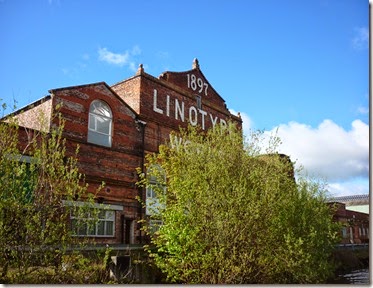 and these amazing ocean liner flats! the closest we’ll get to a transatlantic cruise I think.
and these amazing ocean liner flats! the closest we’ll get to a transatlantic cruise I think.
We did see a kingfisher flash by too but we can’t remember where it was – it may have been yesterday anyway! As we entered the long straight north of Timperley Bridge we could see a double scull in the distance, the rowers resting on their oars. I was hoping for an action shot, but they suddenly shot off into the distance and by the time we caught up with them they were out of the water. On to Waters Meeting – it sounds grand and poetic but we found it rather drab. We passed the Manchester Utd ground (not worth a photo with all its security fencing) and then the much more interesting first view of the Ship Canal and then Pomona Lock.
Soon after 11 we were moored in Castlefield basin opposite the restored Merchants Warehouse, now let as offices though work continues on the ground floor.
We went for an orientation stroll round the basins and had a look at the start of the Rochdale. A hire boat was just starting up on the Cheshire ring – I wonder what time they’ll be finishing tonight? We walked round by the Roman gardens area, where we saw this cutaway section of the foundations of the various iterations of the city wall.
After lunch (the hearty and very welcome soup I made yesterday) we visited the Museum of Science and Industry close by. It occupies five listed buildings and has outside areas too with a platform, rails and station building of the Liverpool and Manchester Railway. An exhibit near the main entrance caught our attention – a replica of ‘Baby’, an experimental computer built in 1948 at Manchester University to prove the concept of digital storage which our modern life now depends on! It weighed 1 tonne and stored a tiny amount of data compared with … I don’t know, a central heating control today? It’s like comparing a narrow-boat with a transatlantic liner! The photo below shows the replica Baby and the three volunteers with whom we had an interesting geeky conversation.
Between this and the main entrance is a replica of an Avro F, the first plane with a completely enclosed cabin. The pilot climbed in through a hatch in the roof. The thing that looks like Meccano in the central window pane is the joystick and he (it probably was a he in 1912) had to sit behind it and stretch his legs along the length of the cockpit
We explored the Textiles gallery and saw a brief demonstration of a loom – more of this later. Then off to the Air and Space gallery across the road in the magnificent Lower Campfield Market Hall, built in 1876. In 1983, after 80 years or so as the City Exhibition Hall, it became a museum.
It contains a fascinating selection of aircraft, cars, motorbikes and bicycles made in and around Manchester. The first exhibit you see is the replica of a triplane built by A V Roe and Company – Avro. I took this photo from the mezzanine floor above.
Just a few pictures from the visit – a Model T Roadster, made by the first Ford factory outside the USA at Trafford Park; a cutaway jet engine; and a kamikaze plane. Like the Avro F just inside the main entrance to the museum, this was unexpectedly small. The railings in front were waist high and the exhibits almost within touching distance.
Then Dave went off to the Power Hall to see the various engines (including a steam locomotive) while I returned to the Textile Hall for the main demonstration. They have examples of the machines which carried out all the steps of cloth production. The cotton bales were roughly broken up then passed through the scutcher, which beat the cotton to knock out seeds and bits of stick. They didn’t demonstrate this – I think it might have broken down, but anyway it produces a lot of dust and fibre in the air. The pad of fibre produced is then carded to align the fibres to produce a roll of cotton which then goes through several stages of spinning - pulling and twisting the fragile fibres together into a strong single thread - to become the yarn which is used to weave cloth.
The spinning machines above were belt driven by electricity, but originally the power would have come from a steam engine. In the original factories, the machines were much closer together than these two and accidents happened – an arm caught in the belt would cause serious injury to an adult, but a child could be whipped up towards the works in the roof and killed.
The spinning machines were noisy but the loom was much worse. The demonstrator showed how the shuttle was threaded then put it into the machine, flicked a lever and stood well back. In real life the operator would have had 6 looms under her control, each needing a new bobbin (and shuttle re-threading) every 6 minutes – so no standing back and watching.
The racket was tremendous, and that was just from one machine. The demonstrator stood well away for the short while it was running. In a weaving shed there could have been a thousand, the air full of dust and fibre and the noise shattering. An exaggerated form of lip-reading, called Mee-maw, was developed to communicate in the weaving sheds, but as your hearing would be permanently damaged within a week, it had to be used outside as well. You had to be careful if you wanted a private conversation!
Life expectancy was poor – if you weren't injured by moving parts you died from lung disease. Loom operators had a life expectancy of 27; when replacing bobbins they had to suck the thread into the shuttle, thus inhaling fibre hundreds of times a day. This meant there was a ready supply of orphans – children as young as five were used to do the jobs in small spaces, such as crawling under machines to remove cotton fibres from the floor – and the machines were not stopped while they did this. Laws were passed to prevent children under 9 from working in factories, but not actually enforced until the Factory Act of 1833. Grim up North? it certainly was if you worked in the mills.
We’ll go back next time we’re in Manchester to see some of the other galleries – it’s brilliant. We’ll spend tomorrow here, then leave Chuffed in a marina for a few weeks. We’re waiting for a phone call from Portland Basin tomorrow.
Dave’s injured foot wasn’t up to strolling up through Deansgate so we had an excellent pint in the nearby Knott Bar, which was still packed with the after-work crowd. We managed to get a seat so ate there too – a delicious pie (Dave) and scrumptious pulled pork burger (me).
9 and a half miles, no locks

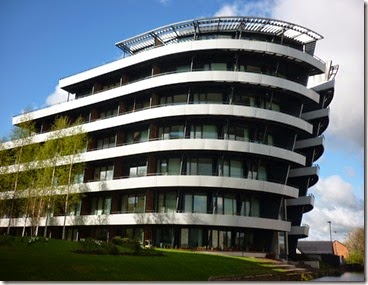
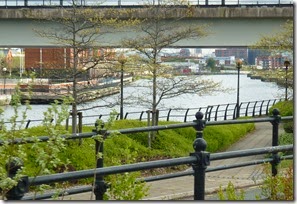
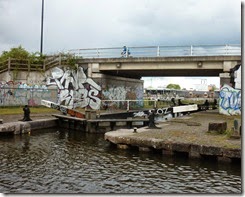


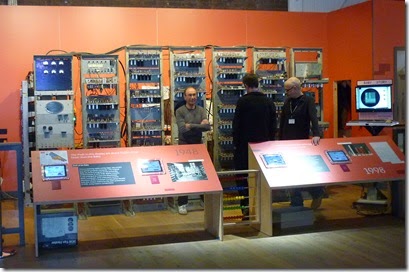


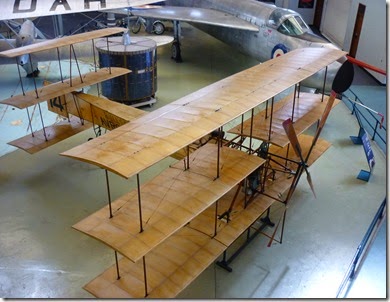
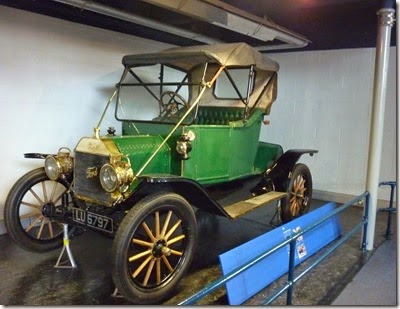


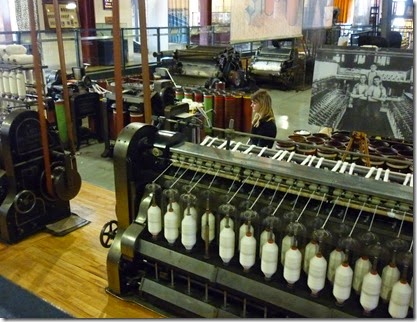


Hi Debbie & Dave,nice talking to you as well Debbie.Glad all was well at Droylsden,you obviously had the same experiences as we did.We're now following your blog and we'll maybe catch up with you again sometime.
ReplyDeleteTake care,Fred.
i woke up in this canal last year after a christmas party - you actually have a picture of where i was when i came to, this might sound weird but thanks for having that picture
ReplyDeleteWell I'm glad you survived to tell the tale! ;)
Delete